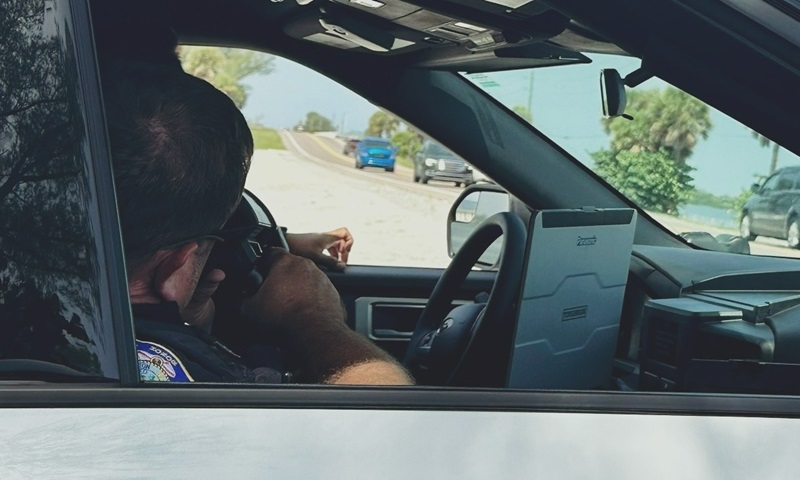
It is an everyday occurrence that some motorists are seemingly oblivious to Speed Limit signs. Whether it be due to distracted driving, tardiness, or whatever other unjustified reason…speed kills! That is why law enforcement officers train in using speed detection devices (“radar guns”) that have a pinpoint laser-focused dot in the reticle, park on the sidelines, and aim to remove rocketeers while also slowing traffic via visual, marked-cruiser presence.
Our cover photo depicts how oncoming traffic looks to a cop behind the laser lens. Initial training in the academy, and state-mandated periodic recertification, thereafter, equips cops for speed enforcement and any subsequent testimony in traffic courts.
Speed-detection devices have graduated in technological applications. The seemingly winking officer or deputy is not flirting but concentrating on moving targets (automobiles) and deciphering the outstanding ones mashing the pedal to the metal the most, accelerating amid other drivers, effectively endangering many.

(Photo courtesy of the California Highway Patrol.)
How is this possible for the naked eye?
A tiny red dot is square in the roughly stamp-size window (some models have rectangular windows, akin to two or three postage stamps altogether) through which the law enforcement officer is viewing, with digital feedback to establish probable cause to conduct a traffic stop for “unlawful speed” (writing the statute number and pertinent data upon the traffic citation). The device has a few buttons to select for the officer to “lock in” what they just observed, swiftly put down the device, and go after the speeder.
For a motorcycle cop using a portable radar gun, there is a “holster” in which to saddle the electronics.

(Photo courtesy of the Jacksonville Sheriff’s Office.)
No need to put down a portable radar gun when the law enforcement officer is in their cruiser equipped with a mounted version bolted to the dashboard. Here is what it looks like when an in-car speed-detection system clocks a motorist waaaaay over the posted limit.
A Florida Highway Patrol spokesperson said: “The impaired driver was observed traveling at speeds of 145 mph on Interstate 75 and 120 mph on State Road 82, refusing to stop for law enforcement.”
When ultimately stopped thanks to a PIT maneuver, the driver tries to flee on foot. (That was several days before Christmas 2023, as per the date readout indicated by the in-car video recording system.) Turns out, she was also well over the BAC (blood-alcohol content) limit.
For either the portable or the in-car mounted version, each must be calibrated by certified technicians for the unit to be duly recognized by the judiciary…should the traffic case go to court.

(Photo courtesy of the Orange County Sheriff’s Office.)
Looking at that 100mph recorded speed in the readout window, an Orange County, Florida, sheriff’s office deputy likely wondered what the driver’s story would entail. Nowhere in Florida is there an autobahn, so…
“If you go 50+ mph over the posted speed limit, you will pay a $1,104 fine with a mandatory court appearance.
“Yesterday afternoon, our OCSO Motor Unit deputies were out combating speeding/aggressive driving when they clocked a driver going 100 mph in a posted 45 mph speed limit zone.
“There is no excuse or justification that would warrant anyone to drive at such reckless speeds putting the lives of others at risk!”
StalkerRadar.com, a major manufacturer of speed detection devices for law enforcement, touts their product as capable of “pinpoint accuracy” and equipped with “anti-jamming technology,” engineered for use “even in rain, snow, blowing dust, and fog.”

(Photo courtesy of the Bradenton Police Department.)
About that pinpoint accuracy, the handheld device’s laser-dot is generally fixed on the oncoming vehicle’s grill, isolating it from any other autos, enabling precision, and supporting testimony regarding how and why the driver is in traffic court…with whatever reason they may have to argue against the violation, objecting to being issued a ticket, aka having their day in court.
As illustrated in the image above, a cop’s traffic enforcement measures include the distance between the officer and the driver detected for unlawful speed and the recorded speed (compared to the posted speed limit).
On the traffic citation, the issuing law enforcement officer also records the location of the violation, the statute number, the fine amount, and court-related information such as the address and date/time.
On the reverse side of the cop’s copy of the ticket are notations of relevant information such as weather conditions (if heavy rain, “Driving Too Fast for Conditions” is noted also, showing how reckless the operator was at the time and how, if not for being stopped by an officer, twisted carnage may have resulted.)
As mentioned above, the date of calibration is listed by the officer. Interestingly, that is generally the first thing a judge wants to see (calibration in effect) before commencing a trial in traffic court. Without that calibration document affirming the speed-detection device is certifiably in functioning order, signed by a bona fide electronics technician, the judge can put the brakes on. (Never experienced/witnessed such a thing, though.)
Speaking of putting the brakes on, speed detection devices play a major role in the enforcement of traffic statutes but it also engenders cops placing themselves close to harm’s way by having to be out there, holding the radar gun, trying to pluck out reckless rocketeers, and having their enforcement actions observed so that others can tap-tap-tap the brakes and moderate their speed.
Speed kills…and cops are laser-focused to prevent lives from demise.